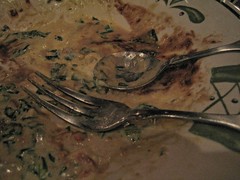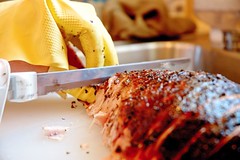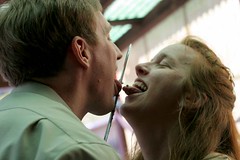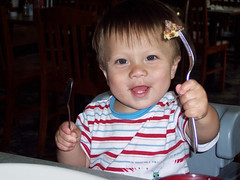Just thought I'd showcase the pasta spoon, for which this blog is named. Can can see here that the pasta was served correctly, in a shallow bowl, but a pasta spoon (entirely unnecessary) was also supplied.
You use the basin of the spoon to twirl the noodles. There is much dispute over whether you can actually pick up the spoon and use it to usher the stray noodles with the fork. I just leave the spoon in the dish and never pick it up.
I'm sure someone will have some opinion on whether this is correct, but it is generally agreed that the pasta spoon is superfluous.
An actual pasta spoon
posted on
12/10/2006
0
comments
![]()
Labels: dining, etiquette, flickr, fork, pasta, plate, spoon, tableware
Nearly done
This year for my Christmas cards, I've been trying to be a little more formal, at least in my addressing. Normally, I'm not a big stickler for protocol, but I decided that this year, I'd try it out.
So, all my cards to husbands and wives are "Mr. and Mrs. John Smith" or "Dr. and Mrs. John Smith." However, I've come upon a few stumbling blocks. First, I'm not really sure what to do when the lady is the doctor and not the man. "Mr. and Dr. John Smith" doesn't sound right at all, and I know that I could actually get away with the "Mr & Mrs" but I'm not real comfortable with that.
I also realized halfway through my cards that Ms doesn't need a period. And that I really don't like the title of Ms. It's a shame that no one uses Miss anymore. And no one uses Master anymore either.
So hopefully, no one will be offended by my Christmas card addressing. We'll see, in any case. At least I can take comfort in the fact that although perhaps insensitive, it is correct by standards of etiquette.
Incidentally, the title of "Master" has greatly fallen out of favor, but is the correct form of address for young boys, usually younger than high school age. However, it is not common anymore, except in some circles.
posted on
11/30/2006
0
comments
![]()
Labels: address, cards, Christmas, correspondence, flickr, title, writing
Thanksgiving tips - carving
This is how I carve a turkey. Your results may vary...
(1) Let the turkey sit for 15 minutes for the meat to rest. Meat should always rest after cooking. Add more time with bigger, thicker pieces of meat, and meat with bone in. Can't get much bigger and bonier than a turkey...
(2) Put your turkey on a solid cutting surface. Use a large chef's knife or a carving knife. I also recommend using a boning knife for disarticulating joints.
(3) First remove the legs at the thigh joint. Pull the leg to expose the joint. Separate the thigh and drumstick. If you like to eat the drumstick in one piece, then you're done. Otherwise, cut the meat from the bone in slices, parallel to the bone.
(4) Disarticulate the wings. Separate each segment. Wings are mostly pointless, but someone may want to eat them. You may put away the boning knife now.
(5) There are two tactics to cutting breast meat. One is to take the whole breast off by taking a boning knife, following the ribcage from top to bottom, and pulling one breast away. Then, you can slice it on a cutting board. The other method is to take a carving knife and cut the breast near the wing joint horizontally, and deeply. This is the base cut. Then you can cut the breast from top to the base cut, and each slice should fall away.
When I first learned, I scoured the web, but learning at home is the best bet. Here's the website that I like best for learning: Butterball's guide to carving a turkey.
posted on
11/21/2006
0
comments
![]()
Labels: carving, flickr, food, holiday, knife, Thanksgiving, turkey
Christmastime is not here yet
If you're a shopper, you know that Christmas shopping doesn't start until Black Friday, the day of the greatest sales in the history of sales. However, this doesn't and hasn't stopped people from putting up their Christmas decorations. In fact, my hospital has already put up Christmas decorations complete with a rooftop light display.
I will take a bold stand here and now and say that it is too early, FAR too early, to be putting up Christmas decorations, playing Christmas music, having festive Christmas-themed coffee cups, selling Christmas coffee blends, putting out Christmas books and music and all this Christmas STUFF!
One should not begin to display such seasonal fare until Thanksgiving evening or the Friday after Thanksgiving.
And please consider that the purpose and point of Christmas is to celebrate the birth of Jesus Christ into our world, and not because of Santa Claus. We are too consumer driven, and have managed to transform December 25 into a spectacular show of opulence and wealth, when in actuality, Christmas began in the simplest of settings: a barn, a manger.
posted on
11/20/2006
0
comments
![]()
Labels: Christmas, decorations, Thanksgiving
Well, excuuuuuuuuuuuse me!
I was reading through the various etiquette websites that exist, and I was alarmed to discover that I had been using "excuse me" and "pardon me" entirely in error. "Excuse me" is for when you are inconveniencing someone. "Pardon me" is when someone is inconveniencing you.
Now, I have found myself saying "Excuse me" in a somewhat sardonic quality when obstructed by someone without the courtesy or foresight to realize their error, but I had always thought that the two phrases were synonymous, but now I know. And now you know.
posted on
11/19/2006
0
comments
![]()
Dining pet peeves
(I don't know who these people are. I just liked the picture!)
So this week, I saw the capital offense: the licking of a knife!
Every now and then, I cheat a lot on dining etiquette. When no one's looking, I eat pastries with a knife only, cutting and stabbing pieces. Shame on me. I can't help myself sometimes. In company though, I'd never dream of it. But I saw someone lick their knife right in front of me. I was appalled. In med school, someone did this in front of me, and I stopped eating for a moment, my brain reeling from this act of incivility.
The inevitable question is why, WHY is it rude to lick your knife. I guess that the idea behind not licking your knife was that you could cut yourself on it (which is still a legitimate concern). But I imagine that when the fork came to be, its dominance of the dining table had to be complete, and this guiltiest of guilty pleasures had to be sacrificed.
The courtesy wave
Whatever happened to the courtesy wave? I was driving through a lot of construction this weekend, and I'm a pretty charitable driver. I'll let cars merge in front of me. But out of the nearly ten cars that I let merge, only one gave me a courtesy wave. And it was of course the big ass truck, not any of the sedans I let through.
For those of you that have no idea what I'm talking about, SHAME ON YOU! Whenever anyone lets you merge into a spot that he needs to slow down for, etc then once you're in, you should wave to the guy that let you in (usually with your right hand through the rear windshield).
Please practice the courtesy wave as often as humanly possible.
posted on
9/16/2006
0
comments
![]()
Labels: courtesy wave, driving, etiquette
How to hold your fork
This cute little guy has an excuse. It's his first fork meal. And we are often quite forgiving of the table manners of children. However, if you're reading this, you have no excuse. A fork should never be held in a clenched fist.
I've seen a lot of people, especially when cutting with a knife, who stab their meat with the fork and a clenched fist while cutting. This is never appropriate.
The fork should always be held with the thumb and first few fingers, using the minimum amount of force needed. This is one of my dining pet peeves, but on the list of egregious dining habits, there's worse.
So, I should explain myself
I thought it would be fun to have a little manners and etiquette blog. I know a lot about manners and etiquette, and although I don't always practice these noble arts, I do enjoy the knowledege.
Anyway, I thought that it would be fun to write about little pieces of arcane knowledge and help the world become a more bizarre place, but more fun, because when you meet someone else that knows these etiquette rules, it can be tremendous fun.
So, what does this have to do with spoons and pasta? Good question. One of the most hotly contested questions in the U.S. is the use of a spoon with pasta. Its purpose, for those of you non-spoon types, is to spin your fork in the bowl of the spoon to get the noodles onto the fork. Then you use the fork to eat the pasta (or some people bring the fork and spoon together to the mouth).
This question would become quite simplified if people stopped serving noodles on plates. Pasta should be served in a shallow bowl, and you can use the side of the bowl to twirl your pasta.
However, in the U.S., everything comes on plates, and pasta suffers, and the spoon for pasta is born.
Waitaminute, you say to yourself. The Italian table is set with a fork AND spoon! Quite right. The spoon is for serving sauce, and not for twirling noodles. However, the use of the spoon for pasta is so commonplace that it is often seen as acceptable, and even in some high class restaurants you may be given a spoon for pasta.
However, far beyond the spoon for pasta, if you want to show yourself an Italian food novice, ask for parmesan on your seafood.
posted on
9/14/2006
0
comments
![]()




